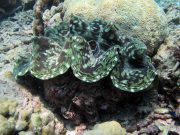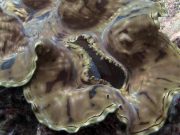Dykning med Jättemusslor
Lanta Marina Liv | Tridacnidae
Jättemusslorna är medlemmar i familjen Tridacninae som består av stora saltvattensmusslor. Det tvådelade skalet har vanligtvis en vågig öppning som aldrig stängs ordentligt och som vetter mot solljuset. De är en vanlig syn under våra dykresor till Koh Lanta.
Den gångjärnsförsedda sidan av skalet är längst ned och fästs vid en hård yta av en stor mängd sega silkestrådar som växer från mellanrummet mellan ventilerna nära gångjärnet. Vissa jättemusslor gräver ner sig i koraller, med större delen av skalet dolt och endast skalöppningen vänd mot solljuset.
Jättemusslorna lever i korallrevens grunda vatten och lever i symbios med encelliga fotosyntetiska alger (zooxanthellae) på ungefär samma sätt som en korallpolyp. Zooxanthellae lever i musslan och producerar mat genom fotosyntes som den delar med musslan.
Musslan vänder skalöppningen och kroppen mot solljuset för att maximera produktiviteten i sin 'algfarm'. Även om jättemusslor är mycket beroende av symbiotiska alger kan de fortfarande filtrera föda som andra musslor.
3 arter finns på denna sida:
Fluted Giant Clam
(Tridacna squamosa)
The Fluted Giant Clam is a medium to large clam, and is easily identified by the rows of leaf-like fluted edges on its shell called 'scutes'. Whilst not always easy to see small details, the scutes provide shelter for small invertebrates such as shrimp, crabs and other small clams.

Fluted Giant Clams @ Koh Bida
The mantle colour varies from greenish brown to yellowish tan to greenish blue or purple, with wavy lines, spots and blotches. There are two openings in the mantle to allow water to pass through, feeding and light to reach the zooxanthellae. It’s not uncommon to find crabs, small fish, shrimp and other animals living within the clam.
This giant clam grows to 40 cm in length and is often found in the open, or close to coral rubble areas, mostly in shallow water areas.
Giant Clam
(Tridacna gigas)

Giant Clam @ Koh Haa
The Giant Clam is the largest bivalve in the world. The shell is typically smooth, however other marine organisms attach themselves to the shell, which in the wild can then appear quite rough.
The shell has four vertical folds which create the ’wavy’ appearance of the mantle, which varies in colour from brown to tan to green through blue to purple. The mantle is fused except for two siphon holes, the longer hole to draw in water, and the smaller hole to expel water. The gills can be seen through the longer hole, and the shell is open during the day to allow sunlight to reach the zooxanthellae.
The Giant Clam grows to 130 cm and is usually found in flat shallow areas with plenty of sunlight. This is a slow growing species which is critically endangered in some areas due to over harvesting for food and shells.
Boring Giant Clam
(Tridacna crocea)
The Boring Giant Clam burrows deep into cracks in the reef and is usually only seen from the top, with only the mantle exposed.
The mantle colour varies from yellow to gold to tan to brown to green to blue to purple.

Boring Giant Clam @ Koh Bida
A row of ‘eyes’ can be seen along the margin of the mantle, and these provide rudimentary ‘vision’ allowing the clam to detect light, dark, and shadows from possible predators.
The clam chooses a location which is exposed to sunlight and attaches itself to the hard coral skeleton using strong silky threads (basal threads) from the hinge of the two shells (valves).

Boring Giant Clam @ Koh Haa
This clam is the smallest of all the giant clams, growing to 15 cm across and may form dense colonies of individuals.
Dykning med Jättemusslor runt Koh Lanta
Dykning och Snorkelutflykter
Om du vill ha en chans att se Jättemusslor på en av våra dagliga högsäsongs dykresor från Koh Lanta, skicka oss ett e-postmeddelande till info@diveandrelax.com.
Följ med på våra dykresor med speedboat under högsäsong till några av Thailands bästa dykplatser och njut av små grupper, korta restider och fokus på personlig service, säkerhet och nöje.
Är du ännu inte certifierad dykare? Lär dig att dyka på Koh Lanta med den 3-dagars SSI Open Water Diver-kursen.
Boka online och spara 10 % på dykresor och dykkurser på Koh Lanta.
Ta Reda på Mer
Guider för Marina Djur och Växter i Indo-Stilla Havet
- Allen, G., Steene, R., Humann, P., DeLoach, N. (2003) Reef Fish Identification, Tropical Pacific. Jacksonville, FL., USA: New World Publications, Inc., ISBN 1-878348-36-1.
- Humann, P., DeLoach, N., (2010) Reef Creature Identification, Tropical Pacific. Jacksonville, FL., USA: New World Publications Inc., ISBN 978-1-878348-44-9
- Debelius, H. (2013) Indian Ocean Reef Guide. Frankfurt, Germany: IKAN - Unterwasserarchiv, ISBN 978-3-939767-52-7.
- Debelius, H. (2004) Nudibranchs and Sea Snails, Indo-Pacific Field Guide. Frankfurt, Germany: IKAN - Unterwasserarchiv, ISBN 3-925919-51-1
- Erhardt, H., Knop, D. (2015) Corals Indo-Pacific Field Guide. Frankfurt, Germany: IKAN - Unterwasserarchiv, ISBN 3-925919-69-4.
- Veron J.E.N., Stafford-Smith M.G., Turak E. and DeVantier L.M. (2016). Corals of the World


